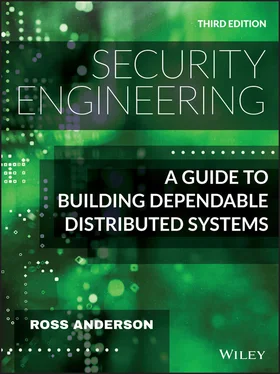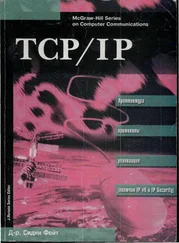Most access control systems set out not just to control what users can do, but to limit what programs can do as well. In many systems, users can either write programs, or download and install them, and these programs may be buggy or even malicious.
Preventing one process from interfering with another is the protection problem . The confinement problem is that of preventing programs communicating outward other than through authorized channels. There are several flavours of each. The goal may be to prevent active interference, such as memory overwriting, or to stop one process reading another's memory directly. This is what commercial operating systems set out to do. Military systems may also try to protect metadata – data about other data, or subjects, or processes – so that, for example, a user can't find out what other users are logged on to the system or what processes they're running.
Unless one uses sandboxing techniques (which are too restrictive for general programming environments), solving the protection problem on a single processor means, at the very least, having a mechanism that will stop one program from overwriting another's code or data. There may be areas of memory that are shared to allow interprocess communication; but programs must be protected from accidental or deliberate modification, and must have access to memory that is similarly protected.
This usually means that hardware access control must be integrated with the processor's memory management functions. A classic mechanism is segment addressing . Memory is addressed by two registers, a segment register that points to a segment of memory, and an address register that points to a location within that segment. The segment registers are controlled by the operating system, often by a component of it called the reference monitor which links the access control mechanisms with the hardware.
The implementation has become more complex as processors themselves have. Early IBM mainframes had a two-state CPU: the machine was either in authorized state or it was not. In the latter case, the program was restricted to a memory segment allocated by the operating system; in the former, it could write to segment registers at will. An authorized program was one that was loaded from an authorized library.
Any desired access control policy can be implemented on top of this, given suitable authorized libraries, but this is not always efficient; and system security depended on keeping bad code (whether malicious or buggy) out of the authorized libraries. So later processors offered more complex hardware mechanisms. Multics, an operating system developed at MIT in the 1960s and which inspired Unix, introduced rings of protection which express differing levels of privilege: ring 0 programs had complete access to disk, supervisor states ran in ring 2, and user code at various less privileged levels [1687]. Many of its features have been adopted in more recent processors.
There are a number of general problems with interfacing hardware and software security mechanisms. For example, it often happens that a less privileged process such as application code needs to invoke a more privileged process (e.g., a device driver). The mechanisms for doing this need to be designed with care, or security bugs can be expected. Also, performance may depend quite drastically on whether routines at different privilege levels are called by reference or by value [1687].
The Intel 8088/8086 processors used in early PCs had no distinction between system and user mode, and thus any running program controlled the whole machine 6. The 80286 added protected segment addressing and rings, so for the first time a PC could run proper operating systems. The 80386 had built-in virtual memory, and large enough memory segments (4 Gb) that they could be ignored and the machine treated as a 32-bit flat address machine. The 486 and Pentium series chips added more performance (caches, out of order execution and additional instructions such as MMX).
The rings of protection are supported by a number of mechanisms. The current privilege level can only be changed by a process in ring 0 (the kernel). Procedures cannot access objects in lower-level rings directly but there are gates that allow execution of code at a different privilege level and manage the supporting infrastructure, such as multiple stack segments.
From 2006, Intel added hardware support for x86 virtualisation, known as Intel VT, which helped drive the adoption of cloud computing. Some processor architectures such as S/370 and PowerPC are easy to virtualise, and the theoretical requirements for this had been established in 1974 by Gerald Popek and Robert Goldberg [1535]; they include that all sensitive instructions that expose raw processor state must be privileged instructions. The native Intel instruction set, however, has sensitive user-mode instructions, requiring messy workarounds such as application code rewriting and patches to hosted operating systems. Adding VMM support in hardware means that you can run an operating system in ring 0 as it was designed; the VMM has its own copy of the memory architecture underneath. You still have to trap sensitive opcodes, but system calls don't automatically require VMM intervention, you can run unmodified operating systems, things go faster and systems are generally more robust. Modern Intel CPUs now have nine rings: ring 0–3 for normal code, under which is a further set of ring 0–3 VMM root mode for the hypervisor, and at the bottom is system management mode (SMM) for the BIOS. In practice, the four levels that are used are SMM, ring 0 of VMX root mode, the normal ring 0 for the operating system, and ring 3 above that for applications.
In 2015, Intel released Software Guard eXtensions (SGX), which lets trusted code run in an enclave – an encrypted section of the memory – while the rest of the code is executed as usual. The company had worked on such architectures in the early years of the Trusted Computing initiative, but let things slide until it needed an enclave architecture to compete with TrustZone, which I discuss in the next section. The encryption is performed by a Memory Encryption Engine (MEE), while SGX also introduces new instructions and memory-access checks to ensure non-enclave processes cannot access enclave memory (not even root processes). SGX has been promoted for DRM and securing cloud VMs, particularly those containing crypto keys, credentials or sensitive personal information; this is under threat from Spectre and similar attacks, which I discuss in detail in the chapter on side channels. Since SGX's security perimeter is the CPU, its software is encrypted in main memory, which imposes real penalties in both time and space. Another drawback used to be that SGX code had to be signed by Intel. The company has now delegated signing (so bad people can get code signed) and from SGXv2 will open up the root of trust to others. So people are experimenting with SGX malware, which can remain undetectable by anti-virus software. As SGX apps cannot issue syscalls, it had been hoped that enclave malware couldn't do much harm, yet Michael Schwarz, Samuel Weiser and Daniel Gruss have now worked out how to mount stealthy return-oriented programming (ROP) attacks from an enclave on a host app; they argue that the problem is a lack of clarity about what enclaves are supposed to do, and that any reasonable threat model must include untrusted enclaves [1691]. This simple point may force a rethink of enclave architectures; Intel says ‘In the future, Intel's control-flow enforcement technology (CET) should help address this threat inside SGX’ 7. As for what comes next, AMD released full system memory encryption in 2016, and Intel announced a competitor. This aimed to deal with cold-boot and DMA attacks, and protect code against an untrusted hypervisor; it might also lift space and performance limits on next-generation enclaves. However, Jan Werner and colleagues found multiple inference and data-injection attacks on AMD's offering when it's used in a virtual environment. [2014]. There's clearly some way to go.
Читать дальше











